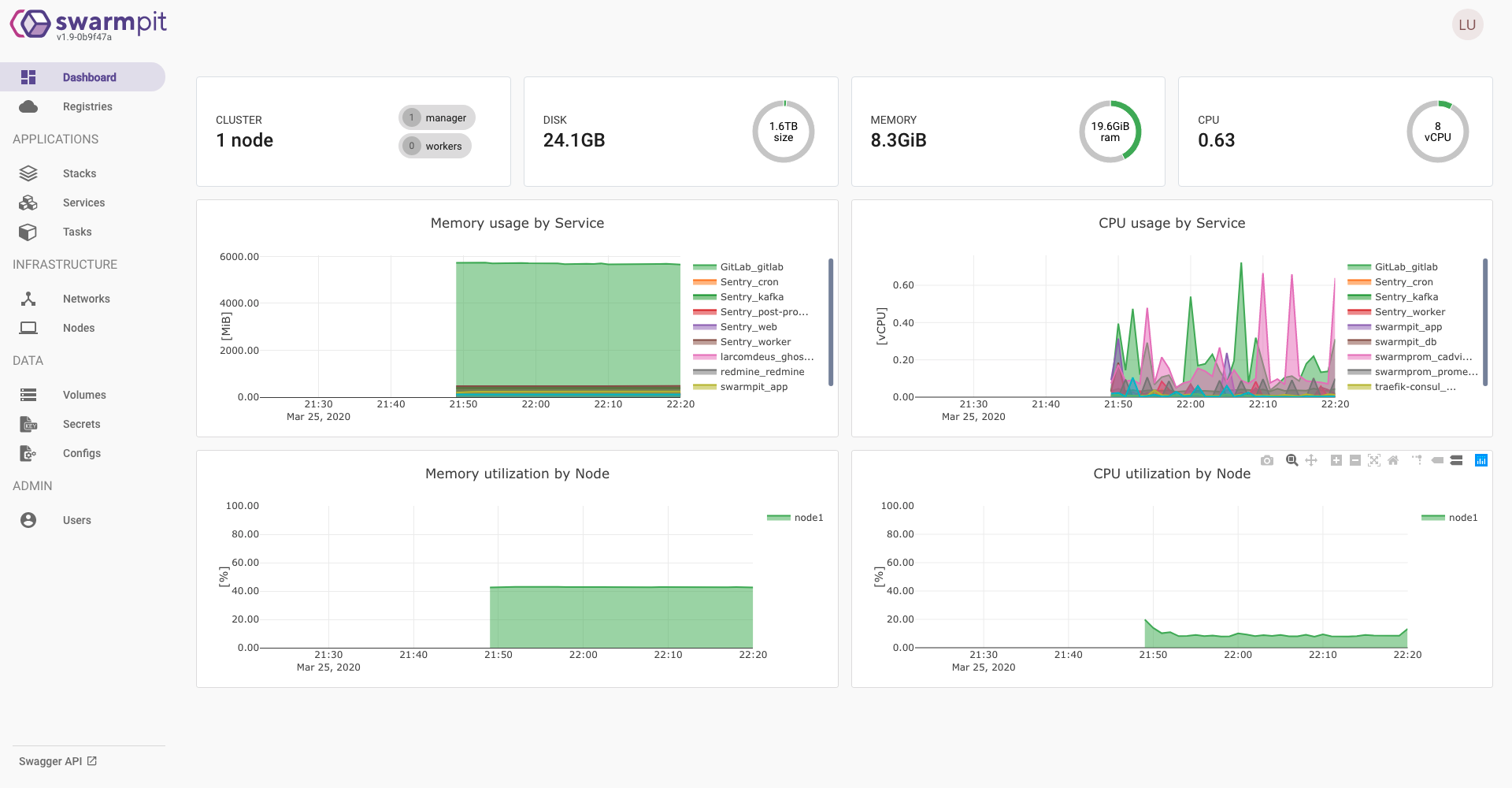Swarmpit web user interface for your Docker Swarm cluster¶
Swarmpit provides a nice and clean way to manage your Docker Swarm cluster.
Follow this guide to integrate it in your Docker Swarm mode cluster deployed as described in DockerSwarm.rocks with a global Traefik HTTPS proxy.
Here's one of the screens:

Preparation¶
-
Connect via SSH to a Docker Swarm manager node.
-
Create an environment variable with the domain where you want to access your Swarmpit instance, e.g.:
export DOMAIN=swarmpit.sys.example.com
-
Make sure that your DNS records point that domain (e.g.
swarmpit.sys.example.com) to one of the IPs of the Docker Swarm mode cluster. -
Get the Swarm node ID of this (manager) node and store it in an environment variable:
export NODE_ID=$(docker info -f '{{.Swarm.NodeID}}')
- Create a label in this node, so that the CouchDB database used by Swarmpit is always deployed to the same node and uses the existing volume:
docker node update --label-add swarmpit.db-data=true $NODE_ID
- Create another label in this node, so that the Influx database used by Swarmpit is always deployed to the same node and uses the existing volume:
docker node update --label-add swarmpit.influx-data=true $NODE_ID
Create the Docker Compose file¶
- Download the file
swarmpit.yml:
curl -L dockerswarm.rocks/swarmpit.yml -o swarmpit.yml
- ...or create it manually, for example, using
nano:
nano swarmpit.yml
- And copy the contents inside:
version: '3.3'
services:
app:
image: swarmpit/swarmpit:latest
environment:
- SWARMPIT_DB=http://db:5984
- SWARMPIT_INFLUXDB=http://influxdb:8086
volumes:
- /var/run/docker.sock:/var/run/docker.sock:ro
networks:
- net
- traefik-public
deploy:
resources:
limits:
cpus: '0.50'
memory: 1024M
reservations:
cpus: '0.25'
memory: 512M
placement:
constraints:
- node.role == manager
labels:
- traefik.enable=true
- traefik.docker.network=traefik-public
- traefik.constraint-label=traefik-public
- traefik.http.routers.swarmpit-http.rule=Host(`${DOMAIN?Variable not set}`)
- traefik.http.routers.swarmpit-http.entrypoints=http
- traefik.http.routers.swarmpit-http.middlewares=https-redirect
- traefik.http.routers.swarmpit-https.rule=Host(`${DOMAIN?Variable not set}`)
- traefik.http.routers.swarmpit-https.entrypoints=https
- traefik.http.routers.swarmpit-https.tls=true
- traefik.http.routers.swarmpit-https.tls.certresolver=le
- traefik.http.services.swarmpit.loadbalancer.server.port=8080
db:
image: couchdb:2.3.1
volumes:
- db-data:/opt/couchdb/data
networks:
- net
deploy:
resources:
limits:
cpus: '0.30'
memory: 512M
reservations:
cpus: '0.15'
memory: 256M
placement:
constraints:
- node.labels.swarmpit.db-data == true
influxdb:
image: influxdb:1.7
volumes:
- influx-data:/var/lib/influxdb
networks:
- net
deploy:
resources:
reservations:
cpus: '0.3'
memory: 128M
limits:
cpus: '0.6'
memory: 512M
placement:
constraints:
- node.labels.swarmpit.influx-data == true
agent:
image: swarmpit/agent:latest
environment:
- DOCKER_API_VERSION=1.35
volumes:
- /var/run/docker.sock:/var/run/docker.sock:ro
networks:
- net
deploy:
mode: global
resources:
limits:
cpus: '0.10'
memory: 64M
reservations:
cpus: '0.05'
memory: 32M
networks:
net:
driver: overlay
attachable: true
traefik-public:
external: true
volumes:
db-data:
driver: local
influx-data:
driver: local
Info
This is just a standard Docker Compose file.
It's common to name the file docker-compose.yml or something like docker-compose.swarmpit.yml.
Here it's named just swarmpit.yml for brevity.
Deploy it¶
Deploy the stack with:
docker stack deploy -c swarmpit.yml swarmpit
It will use the environment variables you created above.
Check it¶
- Check if the stack was deployed with:
docker stack ps swarmpit
It will output something like:
ID NAME IMAGE NODE DESIRED STATE CURRENT STATE ERROR PORT
kkhasdfvce30 swarmpit_agent.ndasdfav5 swarmpit/agent:latest dog.example.com Running Running 3 minutes ago
k8oasdfg70jm swarmpit_agent.i9asdfjps swarmpit/agent:latest cat.example.com Running Running 3 minutes ago
kcvasdft0yzj swarmpit_agent.3jasdfd3k swarmpit/agent:latest snake.example.com Running Running 3 minutes ago
9onasdfzopve swarmpit_agent.r6asdfb20 swarmpit/agent:latest snake.example.com Running Running 3 minutes ago
fxoasdfwjrbj swarmpit_db.1 couchdb:2.3.1 dog.example.com Running Running 3 minutes ago
m4jasdf3369c swarmpit_app.1 swarmpit/swarmpit:latest cat.example.com Running Running 3 minutes ago
- You can check the Swarmpit logs with:
docker service logs swarmpit_app
Check the user interfaces¶
After some seconds/minutes, Traefik will acquire the HTTPS certificates for the web user interface.
You will be able to securely access the web UI at https://<your swarmpit domain> where you can create your username and password.